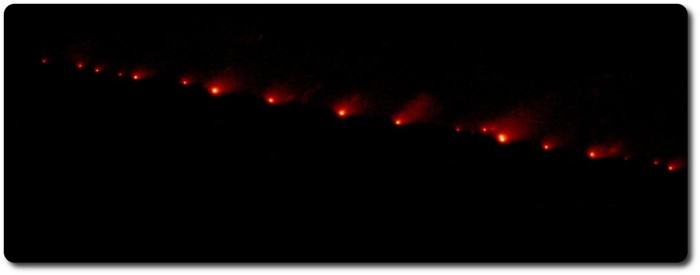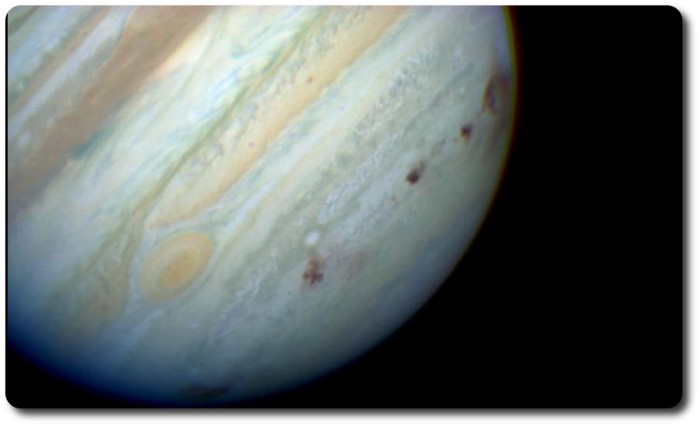
One of the most famous – if not the most famous – space science instruments celebrated 25 years of orbital operations in April 2015.
There can be few people with access to television or media of any description who have not at some point in their lives heard of the NASA / ESA Hubble Space Telescope. Since its launch on April 24th, 1990, and after initial teething problems which required it be fitted with the space equivalent of a pair of spectacles, the Hubble Space Telescope – also referred to as HST, or simply “Hubble” – has brought us some of the most stunning images of the planets of our solar system and deep space ever seen, giving us unique insights into the rest of the solar system, the galaxy in which we reside and the universe beyond.
The major advantage of the Hubble Space Telescope is that it operates above the distorting effect of the majority of the Earth atmosphere. Such is the benefits of such a location, that space telescopes were first proposed as early as 1923, and Hubble itself has a history stretching back as far as 1946, when astronomer Lyman Spitzer wrote Astronomical Advantages of an Extraterrestrial Observatory. For almost 20 years he continued to push the idea as the space programme came into existence until, in 1962, the US National Academy of Sciences took up the call and with three years, Spitzer had been appointed to chair a committee to define the scientific objectives for such a telescope. It was this work that gave birth to the Large Orbiting / Space Telescope in the 1970s, which became Hubble in the 1980s.

Named for the US astronomer Edwin Hubble, regarded as one of the most important observational cosmologists of the 20th century, the HST faced some unique challenges even before it was launched. First and foremost, in order to have as long an operational life as possible, it was designed to be serviced by astronauts, who could replace systems, fix failures, upgrade components, etc. Unfortunately, this also meant that Hubble had to be placed in a relatively low Earth orbit, resulting in further challenges.
Firstly, a low Earth orbit meant the telescope would spend half its time in bright sunlight, making observations in that part of its orbit next to impossible. It also meant an aperture door had to be fitted over the open end of the telescope, which could be closed to avoid the risk of direct sunlight falling onto the telescope’s optics and potentially damaging its science instruments.

More particularly, an orbit around the Earth meant that Hubble would be passing from daylight into night every 48 minutes – and undergoing very wide swings in temperature from extremely hot to very, very cold. These not only would these cause significant heating and cooling issues for the more sensitive instruments on the telescope, they could also lead to expansion and contraction in parts of the telescope’s structure, which in turn could cause small amounts of vibration / movement when it was required to be an ultra-stable platform for space observations.
Nevertheless, despite the technical and engineering challenges the project faced, by the mid-1980s, Hubble was ready, and its launch was scheduled for October 1986. And then fate intervened, in the form of the tragic Challenger disaster of January 1986. This set back the US manned space programme by over two years, and resulted in Hubble’s launch being delayed until the 24th April 1990, when the space shuttle Discovery lifted off from Launch complex 39B at the Kennedy Space Centre on mission STS-31, and the following day successfully deployed the telescope in orbit. All seemed well with the telescope as it underwent on-orbit commissioning over the next couple of weeks; then a series of deep space test images were taken – and indicated a serious flaw in the telescope’s imaging capabilities.
Investigations were begun, and the problem was eventually traced to a error in the telescope’s primary mirror. The HST’s optics are a classic Cassegrain reflector, common to the majority of large professional telescopes, which comprises a very large primary mirror – in the case of Hubble some 2.4 metres (7 ft) across – and a smaller focusing mirror. Both have to be made to exacting tolerances through a process of grinding the reflective surfaces to their required shapes, and in the case of Hubble, the primary mirror had been ground to the wrong shape – by just 2.2 nanometres (a nanometre being one billionth of a metre).

Though tiny, the error was enough to seriously impact Hubble’s ability to carry out cosmological studies, although imaging of very bright objects (such as the planets in the solar system) was still possible. Indeed, and despite being the butt of media jokes and labelled a US $2.5 billion “white elephant”, from 1990 through 1993, Hubble still performed some remarkable work.
However, in 1993, the space shuttle Endeavour lifted-off on mission STS-61, the first of five planned Hubble Servicing Missions. While the huge primary mirror could not be repaired or replaced, the astronauts aboard Endeavour were, among a much broader series of upgrades for the telescope, able to replace one science package on the telescope with a series of corrective optics called COSTAR, and upgrade the telescope’s existing Wide Field Planetary Camera with a more refined version. Intended to counter-act the flaw in the mirror, these upgrades were the equivalent of giving Hubble a pair of glasses – and the results were spectacular.

Since that first operation, Hubble has been serviced four more times between 1997 and 2009, all of which have continued to keep it in good operational order, replacing things like the gyroscope packages that both keep it stable and allow it to be turned to face targets selected for observation, and have significantly updated the science packages it carries, massively increasing its research capabilities.
These missions also served a secondary purpose; while well above the bulk of the Earth’s atmosphere, Hubble still orbits within the second highest layer of the atmosphere, the thermosphere. Although exceedingly tenuous, the thermosphere nevertheless exerts minute, but cumulative drag on objects such as HST and the International Space Station, slowly reducing their orbits. To counter this, the servicing missions flown to HST allowed the space shuttle to gently “lift” Hubble back “up” to its optimal orbit.

In the 25 years of operations, Hubble has contributed to some major scientific discoveries, assisted in resolving some major astronomical issues, witnessed some remarkable solar events, and has raised new cosmological questions. And, of course, it has brought us some of the most stunning images of our galaxy and the universe beyond it, forever changing our perception of the place in which we live.
In honour of it’s namesake, one of the primary elements of Hubble’s mission was to measure the distances to Cepheid variable stars which, because of its position in space, it could do with far greater accuracy than ever before achieved. These observations helped constrain the value of the Hubble constant, used to define the rate at which the universe is expanding (thus helping to more accurately determine the age of the universe).
Prior to HST’s work, estimates of the Hubble constant typically had errors of up to 50%; HST was able to produce measurements with an accuracy of ±10%, which have since been verified using other techniques.
As well as helping to more accurately pin down the age of the universe, Hubble also helped establish the Lambda Cold Dark Matter (“ΛCDM”) model as the “standard” model of Big Bang cosmology, by providing evidence that, rather than slowing down due to the influence of gravity (which would eventually lead to the universe contracting once more into the Big Crunch), the rate of expansion of the universe is actually accelerating, most likely due to the influence of so-called dark energy.
Closer to home, Hubble has returned some of the most remarkable images of our own solar system, and has captured several significant events, such as observing the fragments of comet Shoemaker-Levy 9, which had been pulled apart after passing inside Jupiter’s Roche Limit in 1992. The fragments, strung out in a line like bullets from a gun, eventually impacted with Jupiter’s upper atmosphere in 1994, making it the first direct observation of an extraterrestrial collision of solar system objects.

The observations of Shoemaker-Lvey 9 helped to increase our understanding of Jupiter, and of its role as the “solar systems vacuum cleaner”, as it Hoovers-up debris flying around the solar system (and helps to protect Earth from possible collisions).
Also in reference to Jupiter, and most recently, Hubble has been instrumental in confirming the likely existence of a saltwater ocean under the surface of the Jovian Moon, Ganymede. By studying the motion of Ganymede’s Hubble has tended to confirm that there is an ocean of saltwater around 100 kilometres (60 miles) deep, under the moon’s icy surface crust, which is itself 150 km (90 miles) thick, and this ocean is helping to suppress the interaction between Jupiter’s magnetic field and that of Ganymede.

Currently, Hubble is due to be superseded in 2018 by the long-awaited James Webb Telescope, an even more ambitious mission, which will operate and the Earth-Sun L2 Lagrange point, approximately 1,500,000 kilometres (930,000 miles) from Earth, and will combine the visual astronomy capabilities of Hubble with the infra-red capabilities of another of the Great Observatories Programme, the Spitzer Space Telescope, named for Lyman Spitzer, mentioned towards the top of this article.
Over 25 years, Hubble has, as the oldest of the Great Observatories launched by NASA (and one of only two still in operation, the other being the Chandra x-ray Telescope), added immeasurably to our understanding of our solar system, our galaxy and our universe. It has allowed us to see deeper into space – and further back in time – with a clarity still very much unsurpassed. It has operated – and continues to operate well beyond its expected lifetime, and assuming no serious system failures, could conceivably remain operational well into the 2020s.
So, a belated happy anniversary, Hubble, and here’s to celebrating your 30th, and perhaps even your 35th, in the future!

All images courtesy of NASA / JSC and the Space Telescope Science Institute. This article was held over from April 26th, 2015.
